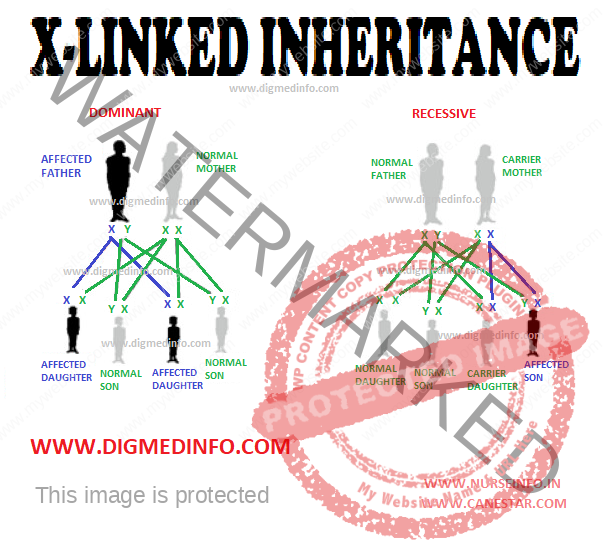X-linked Inheritance – Sex Chromosome Related Disorders, X-linked Recessive Inheritance and X-linked Dominant Inheritance
Sex Chromosome Related Disorders
In all females one of the ‘X’ chromosome derived from either parent undergoes inactivation at the early period of gestation, in a random manner governed by the laws of probability Lyon’s hypothesis (1961). Females, therefore contain a mosaic of tissue cells containing either the maternal or the paternal X-chromosome. Inactivation of the X-chromosome is effected by the action of a gene called the X-inactivation specific transcript which is located in the long arm of the X-chromosomes. Since 50% of the X-chromosomes in carrier females are normal, they do not manifest signs of the disease, but male offsprings suffer from the disease.
X-linked Recessive Inheritance
1. There is ‘oblique’ transmission, i.e., in the pedigree a line drawn through the affected persons is oblique.
2. Only males are affected, females are only carriers.
3. For the offsprings of a carrier female there is a 50% chance of sons being affected and a 50% chance of daughters being carriers.
4. Among offsprings of an affected male, none of the sons will carry the trait, while all the daughters will be carriers.
A female may manifest an X-linked trait if the normal X-chromosome is inactivated during early fetal life or if she is the offspring of a carrier female and affected male, or if the unaffected X-chromosome is structurally abnormal, as in Turner’s syndrome, e.g., hemophilia, Christmas disease, pseudohypertrophic muscular dystrophy.
X-linked Dominant Inheritance
1. The number of females affected is double the number of affected males.
2. The affected male passes Y-chromosome to his sons (and not the X-chromosome). Therefore, all sons of an affected male are normal, whereas all daughters of an affected male are abnormal.
3. The affected female passes the mutant X-chromosome to half her daughters and to half her sons and, therefore, half the daughters and half the sons are affected.
The disease is usually milder in the female, because of the normal gene on the other X-chromosome, e.g. hypophosphatemic type of vitamin D resistant rickets.


